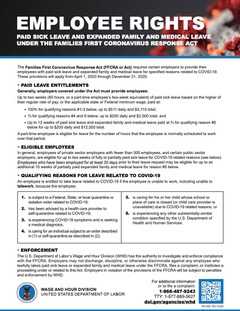MAY 2020, Volume 17, Issue 5
Overview
- What Happens if an Owner Becomes Incapacitated?
- FFCRA Record keeping
- Preparing for Reentry
What Happens if an Owner Becomes Incapacitated?
Preparing your company for your incapacity or death is vital to the survival of the organization. Otherwise, your business will be disrupted, harming your customers, employees, vendors, and ultimately, your family. For this reason, proactive financial planning (including your business and your estate plan) is key. These are some tips on how to protect your company and keep the business on track and operating day-to-day in your absence.
Preparing for the Unexpected
If you are a small business owner, your focus is likely on keeping the company running on a daily basis. While this is important, looking beyond today to what will happen if you can’t run your business should be on the top of your to-do list. If you die or become incapacitated without a plan in place, you will leave your heirs without clear instructions on how to run your company. This can jeopardize the business you worked so hard to build. The right plan along with adequate insurance can help keep your business running regardless of what happens.
Execute the Proper Business Documents
If your company has several owners, a buy-sell agreement is imperative. This contract will outline the agreed upon plan for the business should an owner become incapacitated or die. Provisions in the buy-sell agreement should include:
- how the sale price for the business and an owner’s interest are determined,
- whether the remaining owners will have the option to buy the incapacitated or deceased member’s interest, and
- whether certain individuals can be blocked from participating in the business.
Execute the Proper Estate Planning Documents
A properly executed will or trust will allow you to state how you would like your assets to be transferred, and who will receive these assets at the time of your death. A will or a trust also lets you identify who will take charge of the assets and manage their disbursement (including your business accounts) according to your wishes.
Although a will can be used to pass assets at death, creating and properly funding a trust allows any assets owned by the trust to bypass the probate process making distribution of assets to heirs much faster, private, and may reduce the legal fees and estate taxes your heirs will owe.
Additionally, a trust can help your loved ones manage your trust assets if you become incapacitated. While you are alive and well, you typically act as the trustee of the trust, so you can manage your business and assets with little change from the way you do now. But unlike a will, a trust allows your successor trustee to step in manage things if you become incapacitated. This process avoids court involvement, allows for a smooth transition of trust management (which can be very important if your business is an asset of your trust), and proper continuing care for you in your time of need. Although having a will can be a great way to start, most business owners are much better off with a trust-based estate plan.
Purchase Additional Insurance
Whether you own the business by yourself or are a co-owner, it is important to have separate term life insurance and a disability policy that names your spouse and children as beneficiaries. The money from these policies will help avoid financial hardship while the buyout procedures of buy-sell agreement are being carried out.
Contact an Estate Planning Attorney
Having a plan for your business in the event you are unable to continue managing the company is essential to keep the company going. An attorney can explain the many options you have to protect your enterprise so that you can focus on what you do best . . . running your company.
- - - -
FFCRA Recordkeeping
- Employers should be providing a FFCRA request form for the employee to complete and return.The employer should be completing a FFCRA response form and sending it to the employee granting or denying the benefit.
- Employers are required to retain all FFCRA documentation for four years regardless of whether leave was granted or denied.
- - - -
Preparing for Reentry
As we know, we haven’t entered into Phase 1 yet. We are continuing to spike in southern DE and it’s basically 28 days from the time we are over the crest. Last week the Governor closed schools for the balance of the year and is now mandating face covering when out in public. Employers are required to provide face coverings and hand sanitizer for their employees.
Now is the time to be planning for reentry.
Preplanning:
- Purchasing:
- Face coverings
- Hand sanitizer
- Thermometers
- Cleaning supplies (i.e. Clorox wipes, disinfectant cleaners, one use towels, etc.)
- Touchless faucets and soap dispensers
- No touch trash receptacles
Facility Cleaning:
- Find and schedule deep clean prior to facility opening
- Schedule more frequent facility cleaning
Communication and Training:
- Prohibited activities
- Acceptable practices
- Scheduling common area use
- Signage, directions for conference rooms and traveling in hallways
General Requirements:
All employees and visitors are required to maintain social distancing of 6ft
- Greetings such as shaking of hands or other greetings that do not allow for the 6ft social distance should be eliminated
- Hand sanitizer stations should be provided in common areas (break rooms, copy/printer rooms, entrances)
- Frequent cleaning of common and high touch areas should be performed with cleaners that are effective against COVID-19. Minimum frequency for cleaning of these areas should be twice per shift.
-
Hang Posters to promote good hygiene practices, COVID-19 information, and Posters related to Passive and Active screening
- Hand washing
- Cover Your Cough/Sneeze
- Signs and Symptoms of COVID-19
- Passive Screening Poster
- Active Screening Poster
- All employees and visitors are required to complete self-assessments and follow the guidelines provided
- Only visitors considered “business critical” as defined by the business may be considered for entrance to the facility
- All employees and visitors are required to wear face coverings at all times, except when eating and drinking
- Implement Passive Screening at all locations
- Implement Active Screening at defined locations. The leadership team or safety professional will define locations.
- Where possible, maintain all non-essential internal doors in the open position
Cubicles and Shared Offices
- Cubicles and shared offices shall be evaluated to determine if a 6ft distance can be maintained
- Cubicles and shared offices in which a 6ft distance cannot be maintained should be closed or re-arranged to be able to practically maintain a 6ft distance
- Consider different shifts or starting and ending times
- If social distancing of 6ft in cubicles cannot be achieved, addition of shields constructed a minimum of 7.5ft high (from the floor) for standing workstations and 5.5ft high for seated workstations that encompasses the cubical may be implemented as an alternative.
- Implement visual management such as marking locations of chairs, preferred hallway travel paths as a means to ensure 6ft social distancing is being maintained
- Main hallways that are beside a set of cubicles may be used, without constructing of special shields/barriers, but we should discourage employees and visitors from stopping to talk or loitering. Employees and visitors should be encouraged to use hallways only for walking/traveling as necessary.
Bathrooms
- Consider touchless faucets and soap dispenser to eliminate bacteria transfer and reduction of water usage
- Once occupancy has been reached, employees should wait outside the bathroom area and maintain social distancing of 6ft
- Frequent cleaning with cleaners that are effective against COVID-19
- Consider providing cleaning supplies in each bathroom for use by occupants to clean shared common surfaces such as stall doors, faucet, and sink area
- Consider not using air hand dryers and fabric hand dryers. Disposable hand/paper towels preferred.
Common Areas (Breakroom, Printer Stations, Conference Rooms, etc.)
- Limit the number of occupants in breakrooms and conference rooms, post an updated maximum number of occupants allowed in order to maintain social distancing of 6ft
- Re-arrange tables and limit the number of chairs to facilitate 6ft social distancing
- Remove or tape off excess chairs. The number of available chairs should equal the maximum number of occupants
- Place visual markers to indicate where chairs should be placed
- No more than 10 people in conference rooms while maintaining social distancing
- Consider visual markings around microwaves, coffee machines, and refrigerators to promote social distancing of 6ft and ensure there is hand sanitizer available at these locations. Employees should use hand sanitizer before using any of these commonly shared items.
- Consider providing cleaning supplies for use by occupants
- Where typical congregation of employees may be an issue, consider use of visual markings to promote social distancing
Mailroom
- Locations that receive mail and packages in a central location and distribute to employees shall develop a process that conforms to social distancing requirements of 6ft
- Consider a central drop off location for packages and mail, notify recipients via email; enhance by adding visual markings around the pick-up location of the 6ft distance
Cafeterias/Lunchrooms/Kitchens
- Consider touchless faucets and soap dispenser to eliminate bacteria transfer and reduction of water usage
- Self-serve options shall not be permitted
- Limit the number of occupants, hang a sign with maximum occupancy
- Consider pre-made meals, prepared by cafeteria staff, using proper precautions
- Consider setting up an e-pay system to limit the exchanging of cash and credit cards
- Consider placing a visual marker every 6ft to encourage maintaining social distance
- Consider preparing cutleries with napkins to avoid self-service of these items
- Consider use of individually packaged condiments to avoid self-service
- Consider staggered and extended hours
- Consider additional refrigerator / microwave to allow multiple locations for meal preparation
Elevators
- Care should be taken to limit the number of occupants in an elevator to maintain social distancing of 6ft
- Post a sign with an updated number of recommended occupants in order to maintain social distancing of 6ft
- Consider using an elevator for going up only and mandating using stairs for people to descend
- Consider placing visual markers where individuals should stand to maintain social distancing of 6ft
Policies
- COVID-19 return to work (based on CDC guidelines) – that clearly spells out who is able to return to work and when
- Telework – define eligibility, requirements & expectations, employee suitability, job responsibility, equipment needs, flexible work arrangement not guaranteed
- Office standards – how the office will operate to comply with new CDC guidelines
- Self-assessment – who, when and where this will be done
- Meeting standards – depending on the size of the company, how many conference rooms and how business is conducted while meeting CDC’s guidelines
- Prohibited activities – may want to modify your work rules or general rules of conduct to include what isn’t allowed
- Rehire process – if you have laid off or furloughed employees how, when and in what order will you rehire
- Travel – business and personal travel restrictions
Contact HR Strategies staff at 302.376.8595 or info@hrstrategies.org if you would like support or would like to learn more about the items in this newsletter. Please contact us if you would like to be added to our Monthly Strategies mailing list or if you would like for us to add someone to our mailing list.

